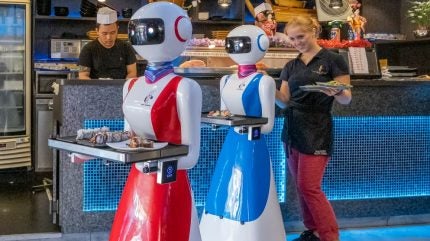
Retailers are turning to robotic solutions in countries where longer life expectancies and falling birth rates are reducing the hospitality talent pool, according to a new report.
GlobalData’s new Future of Consumer report says: “The number of people available to work has been steadily decreasing in developed countries. This is leading to labour shortages across many industries. Parts of Europe, Japan and South Korea are suffering the most from ageing populations and are most in need of a robotics revolution.”
In September 2022, Hotrec estimated that the European Union had around 11 million hospitality jobs, but found that most countries were experiencing significant talent shortfalls. It reported that around a third of positions were unfilled in the Czech Republic. This rose to a quarter in Greece and between 40% and 50% in Poland.
It also noted that “the overall population in the EU27 is set to shrink by 5% between 2019 (447 million) and 2070 (424 million). The working-age population (20-64) will decrease even more markedly from 265 million in 2019 to 217 million in 2070, reflecting fertility, life expectancy and migration flow dynamics.”
The same talent problem is playing out in Japan where The Japan Federation of Service and Tourism Industries Workers’ Unions (STU) conducted a survey which identified that 51% of the hospitality sector had to reduce their operation days, and 33% had had to reduce their hours as a result of having fewer staff members.
In South Korea, The Ministry of Justice (MOJ) and the Ministry of Agriculture, Food and Rural Affairs (MAFRA) announced a new foreign seasonal worker system last year, in an attempt “to resolve chronic manpower shortage in farming and fishing during sowing and harvesting seasons.”

US Tariffs are shifting - will you react or anticipate?
Don’t let policy changes catch you off guard. Stay proactive with real-time data and expert analysis.
By GlobalDataRobotic staff could plug the gap for retailers
Retailers’ staffing headaches could be solved by the rapidly developing robotics sector, as high-efficiency, low-maintenance robotic recruits offer a consistent standard of work over a prolonged period of time.
It’s a rapidly growing sector, and GlobalData predicts that service robot revenue will reach $172.4bn by 2030, growing at a compound annual rate of 12% between 2020 and 2030.
There have already been early examples of robotics in foodservice, including Tesla’s humanoid robot Optimus Gen 2, which caused excitement when a video of it preparing an egg was shared in 2023.
Optimuspic.twitter.com/nbRohLQ7RH
— Elon Musk (@elonmusk) December 13, 2023
Also in 2023, Chipotle and Vebu developed the Autocado, designed to prepare ingredients for Chipotle’s guacamole. They described the prototype as a ‘cobot’ (collaborative robot), as the machine cuts, cores and peels avocados but relies on a human to hand-mash the dish. The Autocado prepares up to 25lbs of avocados at a time, and takes around 50 minutes, promising to reduce production time by half.
Not all solutions will rely on human colleagues, however. Currently used by Tipsy Robot and the TownHouse Duomo Hotel in Milan, Toni is a two-robot team from the KR Agilus series. The robots receive orders directly from guests who can design their own drinks through an app before they are mixed to order by the robotic arms. One fetches ingredients from a rack of bottles while the other makes the product.
For retailers, the full potential of robotic solutions remains to be seen, but GlobalData’s report considers a variety of technologies which look likely to contribute to solving the emerging – and growing – talent gap.
“The future of in-store retail and hospitality will see demographic challenges leading to the wider adoption of service robots,” says the report. “Restaurants and retail spaces will become interconnected and digitalised using technologies like IoT, robotics and AI. These technologies will be used to improve productivity and personalisation.”
The report particularly highlights the likely popularity of service robots, which are already easing staffing pressures in restaurant environments, acting as robotic waiters for food retailers. It explains that “service robots, like robotic waiters and prep robots, will become ubiquitous. Aiming to alleviate the stresses of labour shortages, service robots can help deliver food and clear tables, leaving staff available for face-to-face interactions.”




